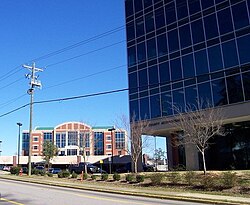
The Midlands region of South Carolina is the middle area of the state. The region's main center is Columbia, the state's capital. The Midlands is so named because it is halfway point between the Upstate and the Lowcountry.[ citation needed ]
Contents
- Counties
- Cities
- Primary cities
- Suburban towns and cities over 10,000 in population
- Suburbs with less than 10,000 inhabitants
- Unincorporated communities
- Higher education
- Media
- Major highways
- Telecommunication
- References
The area has become a major business center in the state, for its growing production of paper products, textile, medical supplies and steel. It is also a center for farming and medical care. The area is also involved in attractions and tourism, featuring shopping, fishing and amusement.
As of the 2020 census the Midlands population was 1,019,439.

